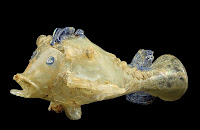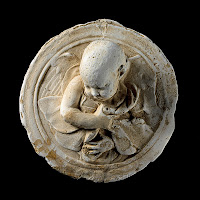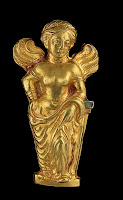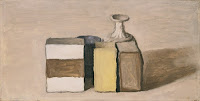Colored Time
4 years ago
Art, Art History, and the Pleasures of the Visual World
 It isn't easy to do 'night art.' Rembrandt, perhaps, set the standard in the iconic masterpiece The Night Watch, when he evoked a dark complicated scene splashed here and there by torchlight. These days you don't find many artists who choose to set their work in the night hours. No doubt it's harder now than it was in Rembrandt's day, as we live in a time when artificial light is so pervasive that few of us know what dark really means. So consider the art of Wendy Goldberg, an artist from Fairfax in Marin County whose velvety medium is pastel on paper. Her landscapes, many as local as she is, come with a fresh, sometimes startling difference of vision, especially
It isn't easy to do 'night art.' Rembrandt, perhaps, set the standard in the iconic masterpiece The Night Watch, when he evoked a dark complicated scene splashed here and there by torchlight. These days you don't find many artists who choose to set their work in the night hours. No doubt it's harder now than it was in Rembrandt's day, as we live in a time when artificial light is so pervasive that few of us know what dark really means. So consider the art of Wendy Goldberg, an artist from Fairfax in Marin County whose velvety medium is pastel on paper. Her landscapes, many as local as she is, come with a fresh, sometimes startling difference of vision, especially when she tackles the night. Shapes of trees or buildings form themselves out of shadows, dark against dark, speaking the truth of how our eyes work at night. Bright lights against the dark spark the same warm, bittersweet feeling as a lit window in a strange town. There is a rich evening color, a purple-blue
when she tackles the night. Shapes of trees or buildings form themselves out of shadows, dark against dark, speaking the truth of how our eyes work at night. Bright lights against the dark spark the same warm, bittersweet feeling as a lit window in a strange town. There is a rich evening color, a purple-blue  just before the sky fades to black, that has always given me a sharp pang of pleasure, and there it is, one of her signature colors. The long rectangular work shown here is a new piece, done on a cold windy hill in San Rafael just before dawn. Like good poetry it suggests and cajoles rather than states a solid fact; as you watch the sky seems to shift from dark into the explosive colors of dawn. Watch for Wendy's work in local shows and open studios. Her website is http://www.wendygoldbergart.com/
just before the sky fades to black, that has always given me a sharp pang of pleasure, and there it is, one of her signature colors. The long rectangular work shown here is a new piece, done on a cold windy hill in San Rafael just before dawn. Like good poetry it suggests and cajoles rather than states a solid fact; as you watch the sky seems to shift from dark into the explosive colors of dawn. Watch for Wendy's work in local shows and open studios. Her website is http://www.wendygoldbergart.com/
 There are a number of great art shows right now in San Francisco, including Martin Puryear at SFMOMA, but it's hard to beat "Afghanistan; Hidden Treasures from the National Museum, Kabul"
There are a number of great art shows right now in San Francisco, including Martin Puryear at SFMOMA, but it's hard to beat "Afghanistan; Hidden Treasures from the National Museum, Kabul"  at the Asian Art Museum. Not only is the work on display breathtakingly beautiful and deeply fascinating as an intimate glimpse of the long ago and far away, but the show itself is a true miracle out of a battered world. The pieces on display are from four sites in Afghanistan and date for the most part from the early centuries of the common era, soon after Alexander made his mark there, when the Silk Road was at the height of vigorous trade among widespread nations, including China, Egypt, India, Rome, and the West. For countless centuries Afghanistan was a rich
at the Asian Art Museum. Not only is the work on display breathtakingly beautiful and deeply fascinating as an intimate glimpse of the long ago and far away, but the show itself is a true miracle out of a battered world. The pieces on display are from four sites in Afghanistan and date for the most part from the early centuries of the common era, soon after Alexander made his mark there, when the Silk Road was at the height of vigorous trade among widespread nations, including China, Egypt, India, Rome, and the West. For countless centuries Afghanistan was a rich  and important land (evidence of trade with
and important land (evidence of trade with  Mesopotamia dates to about 4000 bce) - elaborately worked gold testifies to a wealthy, sophisticated culture whose Nomadic strains helped insure a splendid display of jewelry and burial goods. The heroes behind this exhibition are ordinary Afghans who risked their lives during the Soviet and Taliban years, keeping goods hidden where they could not be stolen or destroyed. In 2003, with the removal of the Taliban, priceless examples of a heritage that belongs to all humankind were discovered intact in a bank vault in Kabul. This amazing show is at the Asian Art Museum until January 25.
Mesopotamia dates to about 4000 bce) - elaborately worked gold testifies to a wealthy, sophisticated culture whose Nomadic strains helped insure a splendid display of jewelry and burial goods. The heroes behind this exhibition are ordinary Afghans who risked their lives during the Soviet and Taliban years, keeping goods hidden where they could not be stolen or destroyed. In 2003, with the removal of the Taliban, priceless examples of a heritage that belongs to all humankind were discovered intact in a bank vault in Kabul. This amazing show is at the Asian Art Museum until January 25.
 Richard Diebenkorn was one of those artists, all too rare, who simply was not capable of making a mistake. His paintings and drawings are full of smudges, paint-overs, and changes; his process of trial and error is always on full display but inevitably, the more he did the better it always got. Diebenkorn died in Berkeley in 1993. He was well known in California but less so with the rest of the country until a major retrospective in the late 90's raised his profile, including a very well-received showing at the Whitney Museum in New York. I saw a small show of his works this weekend at his alma mater Stanford University and, as
Richard Diebenkorn was one of those artists, all too rare, who simply was not capable of making a mistake. His paintings and drawings are full of smudges, paint-overs, and changes; his process of trial and error is always on full display but inevitably, the more he did the better it always got. Diebenkorn died in Berkeley in 1993. He was well known in California but less so with the rest of the country until a major retrospective in the late 90's raised his profile, including a very well-received showing at the Whitney Museum in New York. I saw a small show of his works this weekend at his alma mater Stanford University and, as  always, was knocked out by everything I saw, even the tossed-off birthday card sketches he made for his son. The works on display
always, was knocked out by everything I saw, even the tossed-off birthday card sketches he made for his son. The works on display  belong to his lifelong friend Cary Stanton (they met as fellow Stanford freshmen), and reflect a lot of lovely, personal moments on Santa Cruz Island off the coast near Santa Barbara, a place which is or was largely owned by the Stanton family. Diebenkorn was as at home with abstraction as figuration, with black and white value as with rich color, and with watercolor, pencil, charcoal, ink, and oils.
belong to his lifelong friend Cary Stanton (they met as fellow Stanford freshmen), and reflect a lot of lovely, personal moments on Santa Cruz Island off the coast near Santa Barbara, a place which is or was largely owned by the Stanton family. Diebenkorn was as at home with abstraction as figuration, with black and white value as with rich color, and with watercolor, pencil, charcoal, ink, and oils.
 If you've seen drawings from my series "Things" you won't be surprised to know that I treasure the work of Giorgio Morandi, the subject of a major exhibition at the Metropolitan Museum in New York (through December 14.) Morandi (1890-1964) was a very modest Italian artist who lived quietly in the Bologna apartment he shared with his sisters and almost never went anywhere. He painted bottles - that's it, bottles. Occasionally he added a pitcher or a jar, but mostly it was bottles.
If you've seen drawings from my series "Things" you won't be surprised to know that I treasure the work of Giorgio Morandi, the subject of a major exhibition at the Metropolitan Museum in New York (through December 14.) Morandi (1890-1964) was a very modest Italian artist who lived quietly in the Bologna apartment he shared with his sisters and almost never went anywhere. He painted bottles - that's it, bottles. Occasionally he added a pitcher or a jar, but mostly it was bottles.  Not only that, his palette scarcely made it out of the neutral beige - brown-grey range; the work is the essence of subtle. His paint on the canvas is soft and juicy; it is his one concession to sensuality, but it is a good one and works beautifully. There is something about a Morandi painting that gets under your skin, something you can't explain in long words and high-sounding art talk. His work is the best argument I know for valuing the everyday, and for coming to the understanding that it isn't the subject that makes a great work of art, but the ability of the artist to connect to something deeply human. Don't try to make those bottles into anything they aren't - they're just bottles, but that's enough. Find more information about the Met Exhibit at http://www.metmuseum.org/home.asp
Not only that, his palette scarcely made it out of the neutral beige - brown-grey range; the work is the essence of subtle. His paint on the canvas is soft and juicy; it is his one concession to sensuality, but it is a good one and works beautifully. There is something about a Morandi painting that gets under your skin, something you can't explain in long words and high-sounding art talk. His work is the best argument I know for valuing the everyday, and for coming to the understanding that it isn't the subject that makes a great work of art, but the ability of the artist to connect to something deeply human. Don't try to make those bottles into anything they aren't - they're just bottles, but that's enough. Find more information about the Met Exhibit at http://www.metmuseum.org/home.asp

 knowledge with adults, families, and anyone else interested in getting more out of the wonderful world of art. No homework, no papers, no
knowledge with adults, families, and anyone else interested in getting more out of the wonderful world of art. No homework, no papers, no  reading - just the pleasure of better understanding and enjoying art and art history. ArtSmartTalks will also be available as custom classes for travel, special occasions, and office events, and I'm planning to organize at least one travel opportunity each year. Visit my website http://www.artsmarttalk.com for information and details.
reading - just the pleasure of better understanding and enjoying art and art history. ArtSmartTalks will also be available as custom classes for travel, special occasions, and office events, and I'm planning to organize at least one travel opportunity each year. Visit my website http://www.artsmarttalk.com for information and details.